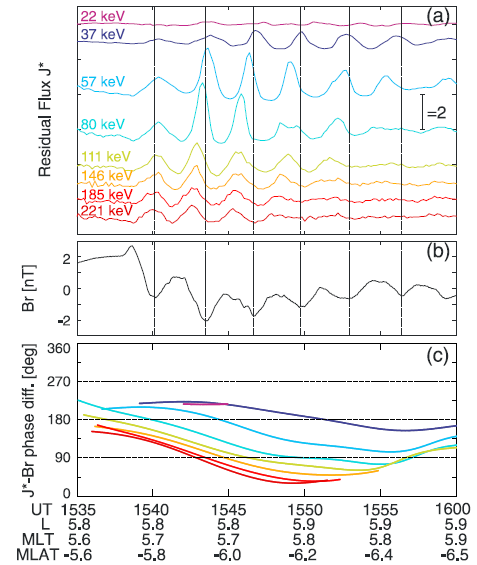Imprints of impulse-excited hydromagnetic waves on electrons in the Van Allen radiaiton belts Xu-Zhi Zhou, Zi-Han Wang, Qiu-Gang Zong, Seth G. Claudepierre, Ian R. Mann, Margaret G. Kivelson, Vassilis Angelopoulos, Yi-Xin Hao, Yong-Fu Wang, and Zu-Yin Pu
Ultralow frequency electromagnetic oscillations, interpreted as standing hydromagnetic waves in the magnetosphere, are a major energy source that accelerates electrons to relativistic energies in the Van Allen radiation belt. Electrons can rapidly gain energy from the waves when they resonate via a process called drift resonance, which is observationally characterized by energy-dependent phase differences between electron flux and electromagnetic oscillations. Such dependence has been recently observed and interpreted as spacecraft identifications of drift-resonance electron acceleration. Here we show that in the initial wave cycles, the observed phase relationship differs from that characteristic of well-developed drift-resonance. We further examine the differences and find that they are imprints of impulse-excited, coupled fast-Alfven waves before they transform into more typical standing waves. Our identification of such imprints provides a new understanding of how energy couples in the inner magnetosphere, and a new diagnostic for the generation and growth of magnetospheric hydromagnetic pulsations.

We are grateful to Paul Song and Andrei Runov for helpful discussions, and to Judy Hohl for polishing the English syntax of the paper. This study was supported by NSFC grants 41421003 and 41474140, and was made possible by the Van Allen Probes mission with data available at http://www.rbsp-ect.lanl.gov. The wavelet package used in this study, developed by Aslak Grinsted, John C. Moore and Svetlana Jevrejeva, is available at http://noc.ac.uk/using-science/crosswavelet-wavelet-coherence.
